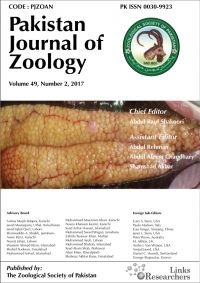Distributional Patterns of Carabid Beetles under Humid Subtropical Climate in Croplands of Sialkot
Distributional Patterns of Carabid Beetles under Humid Subtropical Climate in Croplands of Sialkot
Somia Liaqat, Mubashar Hussain*, Kiran Aftab, Maryam Khalid and Suleman Hussain Shah
ABSTRACT
Pakistan with its diverse climatic and topographical features, is expected to harbor a great diversity of insect species; however, insect fauna of global significance lacks taxonomic and ecological exploration in Pakistan. We explored species diversity and community composition of carabid beetles from croplands. Sampling was conducted fortnightly from August 2020 to July 2021 from district Sialkot i.e., Sialkot, Sambrial, and Pasrur. Specimens were collected by handpicking during the day while pitfall traps were used for nocturnal sampling. Diversity indices and similarities percentage (SIMPER) were calculated for all study sites. We reported 15 species belonging to four subfamilies, six tribes, and eight genera. Calosoma inquisitor (15.18%), Pheropsophus verticalis (12.37%), and Pheropsophus darwini (11.54%) were the most abundant species in district Sialkot. The values of diversity indices calculated for different sites show high species diversity and evenness in Sambrial (D = 0.09, e˄H/S = 0.94) followed by Pasrur (D = 0.08, e˄H/S = 0.93) and Sialkot (D = 0.11, e˄H/S = 0.84). Species richness was highest in Pasrur (H = 2.49) followed by Sambrial (H = 2.42) and Sialkot (H = 2.22). Galerita bicolor and Galerita lecontei veracrucis were reported as new to Pakistan. The study emphasized that ground beetles are one of the key components of agroecosystems and need to be explored extensively concerning accelerated habitat modification and habitat types.
To share on other social networks, click on any share button. What are these?










